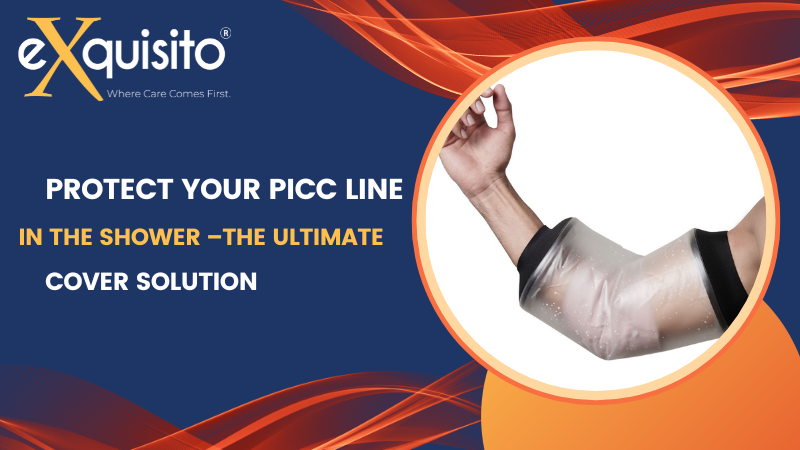A PICC line, or peripherally inserted central catheter, is a thin, flexible tube inserted through a vein in the arm and threaded into the larger veins near the heart. PICC lines are used to administer medications, fluids, and nutrition directly into the bloodstream for an extended period, often weeks or months.
They are commonly used in people who require long-term treatment for conditions such as cancer, infections, or chronic illnesses. While PICC lines are a valuable tool for medical treatment, they also require special care to prevent infection and other complications.
Why PICC Line Protection is Important in Showers?
When you have a PICC line, protecting it from getting wet during a shower is important. Getting the PICC line wet can lead to bacterial infections, skin irritation, or even damage to the line itself. That’s why healthcare professionals highly recommend using a waterproof PICC line cover in the shower.
PICC line covers are designed to fit securely over the PICC line, providing a watertight seal that keeps water from getting inside the line. With a waterproof PICC line cover, you can safely shower without worrying about damaging the line or risking an infection.
In addition to protecting the PICC line from water damage, a PICC line cover can also help prevent accidental dislodgement of the line during showering. This is especially important for active patients who have difficulty staying still during a shower.
Overall, PICC line protection is critical for maintaining the health and safety of patients with PICC lines. By using a waterproof PICC line cover in the shower, patients can shower safely and with peace of mind, knowing that their PICC line is well-protected.
Types of PICC Line Covers for Showers
Several types of PICC line covers are available for showers, each with unique features and benefits. Here are some of the most common types of PICC line covers:
Disposable PICC line covers
These are one-time-use covers made of waterproof materials such as plastic or latex. Disposable PICC line covers are easy to use and dispose of after each shower, making them a convenient option for some patients.
Reusable PICC line covers
These covers are made of durable, waterproof materials such as silicone or rubber and can be used multiple times. Reusable PICC line covers are cost-effective for patients who must shower frequently.
Custom-fit PICC line covers
These covers are designed to fit the patient’s specific PICC line measurements and can provide a more secure fit than one-size-fits-all covers. Custom-fit PICC line covers may be made of materials such as silicone or neoprene and can be reusable or disposable.
Shower sleeves
These are full-arm sleeves made of waterproof material that covers the entire arm, including the PICC line. Shower sleeves provide additional protection against water and can be a good option for patients needing extra protection or sensitive skin.
Shower belts:
These belts or straps made of waterproof material wrap around the chest or waist, securing the PICC line cover in place. Shower belts are a good option for patients with trouble keeping the PICC line cover in place during showering.
When choosing a PICC line cover for the shower, it’s important to consider factors such as comfort, durability, and ease of use. Your healthcare provider can help you select the type of cover for your specific needs.
How to Use a PICC Line Cover for Showers
Using a PICC line cover for showers is essential to protect your PICC line from water damage and bacterial infections. Here are the basic steps to follow when using a PICC line cover for showers:
Clean your PICC line site: Before showering, clean the area around your PICC line with soap and water. Dry the area completely before covering it with the PICC line cover.
Choose the right cover: Select a PICC line cover that fits your PICC line properly and provides a watertight seal. If you’re unsure which type of cover to use, ask your healthcare provider for guidance.
Put on the cover: Slide the PICC line cover over your arm and line up the opening with your PICC line. Ensure the cover is snug and secure, with no gaps or leaks.
Take a shower: With the PICC line cover in place, you can safely shower without worrying about getting the PICC line wet. However, it’s important to avoid high-pressure water sprays and excessive rubbing or to scrub around the PICC line site.
Remove the cover: After showering, carefully remove the PICC line cover and dispose of it if it’s a disposable cover. If you’re using a reusable cover, clean and dry it thoroughly before storing it for future use.
Inspect your PICC line site: After showering, check your PICC line site for any signs of moisture or damage. If you notice any problems, contact your healthcare provider immediately.
By following these steps and using a PICC line cover for showers, you can help ensure the safety and effectiveness of your PICC line treatment. Always follow your healthcare provider’s instructions for caring for your PICC line and using a cover for showers.
Tips for Maintaining Your PICC Line Cover
Proper care and maintenance of PICC line covers can help extend their lifespan and ensure they continue providing effective protection. Here are some tips for maintaining your PICC line cover:
Clean the cover regularly: If you’re using a reusable PICC line cover, clean it thoroughly after each use. Follow the manufacturer’s instructions for cleaning and disinfecting the cover, and ensure it’s completely dry before storing it.
Inspect the cover regularly: Before each use, check the PICC line cover for any signs of wear or damage, such as cracks or tears. If you notice any problems, replace the cover immediately.
Use a backup cover: It’s a good idea to have a backup PICC line cover on hand if your primary cover becomes damaged or unavailable. This can help ensure you always have a safe and effective way to protect your PICC line during showers.
Avoid exposure to extreme temperatures: Do not expose your PICC line cover to extreme temperatures, as this can cause damage to the cover or compromise its effectiveness. Store the cover in a cool, dry place away from direct sunlight.
Follow your healthcare provider’s instructions: Always follow your healthcare provider’s instructions for caring for your PICC line and using a cover for showers. They may have specific recommendations for the cover type, how often to clean it, and when to replace it.
By following these tips, you can help maintain the effectiveness of your PICC line cover and protect your PICC line from water damage and infections.
Factors to Consider When Choosing a PICC Line Cover for Showers
Choosing the right PICC line cover for showers is important to protect your PICC line from water damage and infections. Here are some factors to consider when choosing a PICC line cover for showers:
Size: The PICC line cover should fit snugly around your arm and provide a watertight seal. Measure your arm circumference and choose a cover that fits properly.
Material: PICC line covers are available in different materials, such as latex, silicone, or polyurethane. Consider any allergies or sensitivities you may have when choosing a material.
Durability: Choose a durable cover that can withstand repeated use and cleaning. Some covers are designed for single use, while others are reusable and can be cleaned and disinfected after each use.
Visibility: Some PICC line covers are transparent, allowing you to see and monitor the PICC line for any signs of infection or damage.
Ease of use: Choose a cover that is easy to put on and take off and does not require excessive stretching or pulling.
Healthcare provider’s advice: Always consult your provider before choosing a PICC line cover for showers. They may have specific recommendations based on your individual needs and medical history.
By considering these factors and consulting with your healthcare provider, you can choose a safe, effective, and comfortable PICC line cover for showers.
Conclusion:
Protecting your PICC line during showers is crucial to prevent water damage and infections. A PICC line cover can provide a simple and effective solution for keeping your line dry and safe during showering.
When choosing a PICC line cover, consider size, material, durability, visibility, ease of use, manufacturer’s recommendations, and your healthcare provider’s advice. Once you have a suitable cover, follow the manufacturer’s instructions for use and cleaning, and inspect it regularly for signs of wear or damage.
By taking these precautions and using a PICC line cover for showers, you can help maintain the integrity of your PICC line and reduce the risk of complications.

